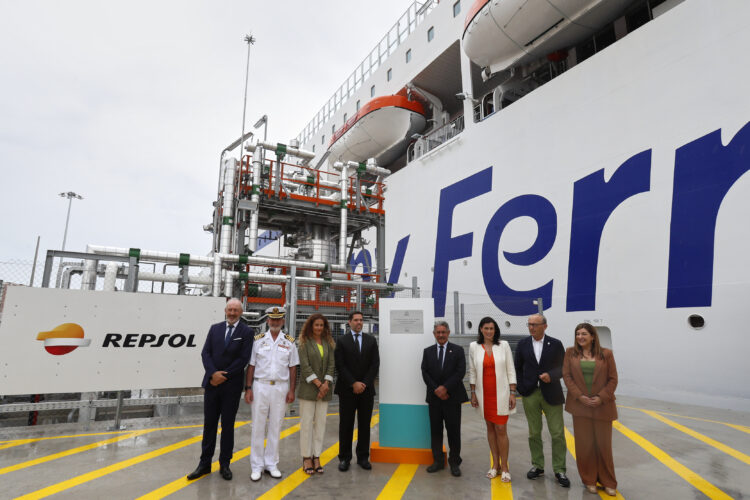Repsol’s second LNG bunker terminal in Santander opens to fuel Brittany Ferries’ Santoña
- The inauguration of the LNG bunker terminal in Santander, Northern Spain follows a collaboration agreement Repsol signed with Brittany Ferries in 2019. It comes after the opening of a similar LNG facility in Bilbao last year.
- Brittany Ferries’ Santoña is already being re-fuelled in Santander with LNG. This cuts air quality emissions like particulates and SOx to virtually zero and will reduce annual CO2 emissions by an estimated 12,000 tons.
Energy company Repsol has inaugurated its second liquefied natural gas (LNG) supply terminal. The inauguration took place in Santander Spain on 7th June and was attended by Repsol’s Executive Managing Director of Circular Economy and Industrial Transformation, Juan Abascal and Brittany Ferries’ CEO Christophe Mathieu.
The terminal comprises a cryogenic tank with a storage capacity of 1,000 cubic meters. It follows the opening of an LNG bunker facility in Bilbao last year. The two facilities are part of a collaboration agreement that Repsol signed with Brittany Ferries in 2019 for the supply of LNG for ships serving Spanish routes.
Santander’s terminal is designed to allow access for any type of vessel. It also allows the simultaneous loading of passengers and fuel, optimising operations and thereby helping cut emissions during port operations. The new terminal is co-financed by the European Commission through the CEF-Connecting Europe Facilities Program.
Brittany Ferries’ newest ship Santoña is already using the port of Santander bunker terminal. By the end of the first year of operations, it is estimated its emissions of CO2 will have been cut by around 12,000 tons.
“We are in the midst of the largest fleet renewal programme in our history and LNG fuel is a key part of our sustainability strategy,” said Christophe Mathieu CEO Brittany Ferries. “But we can only realise the potential of these ships if we have partners like Repsol to provide the fuel and refuelling infrastructure. That’s why this second terminal in the port of Santander is so important to us.”
Juan Abascal, Executive Managing Director of Circular Economy and Industrial Transformation at Repsol said, “this new terminal, that we have just inaugurated, is another step in Repsol’s commitment to the energy transition and the decarbonization of the maritime sector. It also contributes to achieving Repsol’s goal of becoming zero net emissions by 2050 and facilitates Brittany Ferries’ LNG bunkering operations in northern Spain.”
Repsol has extensive experience in this type of supply, having carried out more than one hundred and fifty LNG bunker operations to thirty-two different vessels in eight Spanish ports in recent years.
LNG is a maritime fuel that reduces CO2 emissions by 20% and minimizes the emissions of sulphur dioxide, nitrogen dioxide, and particles to practically zero. Its use reduces emissions immediately in a sector where electrification currently is not a viable alternative, making this fuel a solution that will help achieve decarbonization in the future. In addition, LNG-fuelled ships can also consume bio-LNG without the need to modify their engines, which will further reduce emissions.
-Ends-
About Brittany Ferries
Brittany Ferries was conceived in 1972, starting life as a freight-only service on 2nd January the following year. The first ferry (Kerisnel) linked Roscoff in Brittany with Plymouth in the South of England and carried a cargo of cauliflowers and cognac. Since then the company has progressively launched, then strengthened its shipping routes. This year, Brittany Ferries celebrates 50 years at sea. Millions of passengers and businesses transporting goods by sea across the so-called Atlantic Arc (France, UK, Spain and Ireland) rely on the links forged over the decades. In addition to cutting congestion and emissions on busy roads, these motorways-of the sea have helped enrich local communities, creating jobs, nurturing international tourism.
More details here: corporate.brittany-ferries.com/en/
Images:
https://brittanyferriesnewsroom.com/image-library/
Key figures:
- Turnover: €444.7 million last year compared with €469 million in 2018-19.
- Fleet renewal: Four new LNG-powered vessels to join the fleet (2022-2025) including two LNG-hybrids
- Employment: Around 2,500 employees, including 1,600 seafarers (full-time equivalent)
- Passengers: 1.84 million compared with 2.5 million in 2018-19
- Freight: 167,711 units last year versus 201,554 in 2018-19
- 12 ships connecting France, the United Kingdom, Spain and Ireland, via 14 maritime routes
- 12 ports: Roscoff, Saint-Malo, Cherbourg, Caen, Le Havre, Plymouth, Portsmouth, Poole, Cork, Rosslare, Santander, Bilbao.
Press contacts:
Nigel Wonnacott [email protected]
Christopher Jones [email protected]
 News
News
